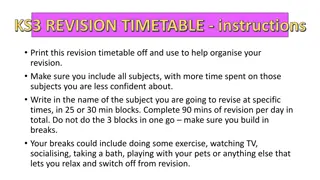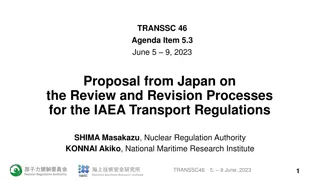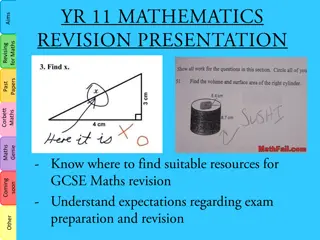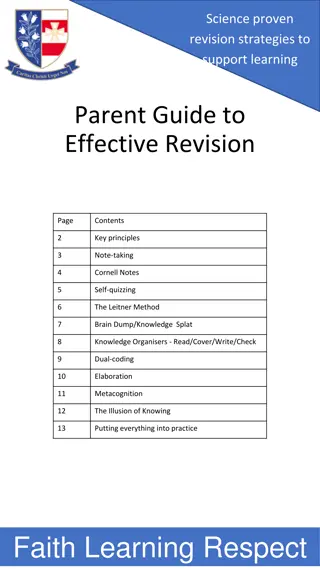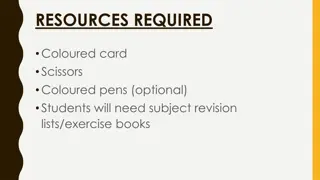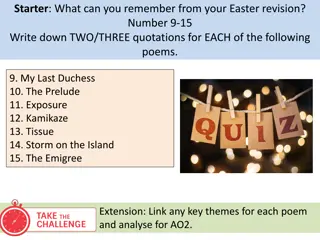
Understanding Speed, Distance, and Time Concepts in Physics
Explore key concepts such as speed calculation, acceleration, distance-time graphs, and velocity in this physics revision guide. Learn how to interpret graphs, calculate speeds, and understand the relationship between distance, time, and speed.
Download Presentation

Please find below an Image/Link to download the presentation.
The content on the website is provided AS IS for your information and personal use only. It may not be sold, licensed, or shared on other websites without obtaining consent from the author. Download presentation by click this link. If you encounter any issues during the download, it is possible that the publisher has removed the file from their server.
E N D
Presentation Transcript
P2 Higher Revision - The harder bits
speed = distance / time taken acceleration = change in speed / time taken force = mass acceleration work done = force distance power = work done / time kinetic energy = mv2 Gravitational potential energy = mgh weight = mass gravitational field strength Momentum = mass x velocity Force = change in momentum / time Force on a spring = spring constant x extension Energy = 0.5 x spring constant x extension2 Turning Moment = Force x distance from pivot Mechanical advantage = Load / Effort Pressure = Force/Area Change in Pressure = Change in depth x density of liquid x gfs
Speed, distance and time. A dog runs 75 metres in 15 seconds. 1: What would we use to measure the time and the distance accurately? 2: Which equation would you use to work out the speed? 3: What is the speed of the dog? We have worked out that the speed of the dog is 5 m/s If the speed of the dog increased to 10 m/s, how long would it now take to run the 75 metres?
Speed and distance / time graphs Distance (meters) A 40 30 B 20 C 10 Time (secs) 0 5 10 15 20 What does the steepness (gradient) of a distance / time graph tell us? What is the speed of C? Which is going fastest, A,B, or C?
Higher Draw a distance / time graph for: A: an object that is speeding up B: an object that is slowing down m/s2 Acceleration is measured in .. Higher: - Acceleration is a change in what?
Acceleration and speed / time graphs Speed (m/s) A 10 8 6 B 4 C 2 Time (secs) 0 5 10 15 20 What does the steepness (gradient) of a speed / time graph tell us? What is the acceleration of A? How far has C moved in the first 10 seconds?
Higher Draw a speed / time graph for: A: an object that has increasing acceleration B: an object that has decreasing acceleration THIS DOES NOT MEAN SPEEDING UP AND SLOWING DOWN!
Speed combined with direction Velocity is .. Positive, eg 6 m/s Negative, eg - 6 m/s What is the relative velocity in the above?
Relative Velocities 6 m/s 2 m/s The relative velocity is m/s
20/03/2025 Vector quantities have a magnitude and units, but also have a specific direction.
Forces as vectors Reaction (Normal) 10000N 300N 1000N Air Thrust Resistance Weight 10000N Lots of forces! Free body force diagram
If a cars speed changes from 5 m/s to 15 m/s in 2 seconds, what is the car s acceleration? Change in speed = 10 m/s and it took 2 seconds, so acceleration = 10/2 = 5 m/s2
Force = mass x acceleration, so the force on the person will be less if acceleration is a smaller number Or we could say Force = change in momentum / time so the force on the person will be less if the time to stop is longer
Force What force is required to accelerate a cannonball at 3 m/s/s if the mass of the ball is 8 Kgs? Force = mass x acceleration So force = 8 x 3 = 24 Newtons
How are mass and weight related? What is mass measured in? What is weight measured in? Which one would be different on the moon?
Kinetic Energy What is kinetic energy? What 2 things does the amount of kinetic energy depend on? Kinetic energy = m v2 IF YOU ARE DOING HIGHER, REMEMBER: Doubling the speed will quadruple the amount of kinetic energy so the braking distance will also quadruple. What will tripling the speed do?
Gravitational Potential Energy What type of energy do objects have if they are high up? What does the amount of GPE depend on? GPE = m g h where g is the gravitational field strength What happens to the GPE of an object when it falls? If an object has reached terminal velocity, what happens to the GPE lost when it falls further?
Newtons Third Law Every action has an equal and opposite reaction
Falling objects Why do things accelerate as they fall? What force acts upwards as an object falls? If these 2 forces are equal, what happens to the speed of the object? What happens if the air resistance is increased?
Higher: Larger area more air resistance (drag) lower terminal velocity How does the gravitational field strength vary at different places on the Earth
More on air resistance Lots of air resistance so lower top speed Less air resistance so higher top speed
Momentum What does the amount of momentum depend on? Momentum = mass x velocity Also, force = change in momentum / time This equation is important in car safety because it means that if the time taken to stop is longer, then the force on the body will be less. Hurts a lot! Not too bad!
Conservation of momentum Momentum is always conserved in any event or interaction: initial momentum final = momentum When a snooker ball collides with another, what happens to the momentum of each ball? Momentum is not created or lost, but transferred from one object to the other. forward_arrow_colour
If a gun fires a bullet at 300 m/s, what is the recoil velocity of the gun? Mass of gun + man = 100 kgs and mass of bullet = 20 grams. Momentum before gun is fired = 0 After gun is fired: momentum to the right = 0.02 x 300 = + 6 kg m/s momentum to the left = - 100 x V, where V is the recoil velocity of the gun. Therefore 6 100V = 0 6 = 100V V = 0.06 m/s
Work Done and Power Which equation do we use to work out the amount of work done? What work is done when a man pushes a donkey 10 metres along a road using a force of 50 Newtons? Work done = Force x distance So work done = 10 x 50 = 500 Joules http://3.bp.blogspot.com/_IYWi0S9u_jU/R2LPsfSxRCI/AAAAAAAAAB4/hrLXjlUNLbM/s320/man+lifting+cartoon.gif Why is no work being done by the man? If it took the man 100 seconds to push the donkey, what is the power in the man s arms? Power = work done / time So power = 500 / 100 = 5 Watts
Work Done and Power higher The man does 600 joules of work when he pushes the donkey 10 metres. What force does he use? Work done = Force x distance So 600 = F x 10 F = 60 Newtons If the power in the man s arms is 30 Watts, how long would it take to push the donkey? Power = work done / time So 30 = 600 / t So t = 20 seconds
If we look at the power of different cars, what difference is it likely to make if a car is more powerful? .Uses more fuel and produce more pollution Higher: Work done = force x distance Power = work done / time So power = force x distance / time Since distance / time = speed, we can say Power =force x speed You need to understand the derivation of this equation and be able to use it.
SPRING CONSTANT Force = spring constant x extension (N) (N/m) (m) F = kx Energy = 0.5 x spring constant x extension2 E= 0.5kx2 20/03/2025
force transferred here Plenary force applied here Pressure inside all parts of the hydraulic system is the same. Calculate the pressure exerted on the liquid if a force of 5N is applied to a small area of 1cm2. Calculate the force the pressure of the liquid exerts on a larger area of 10cm2. F = 5 N/cm2 x 10cm2 = 50N P = 5N 1cm2 = 5 N/cm2









